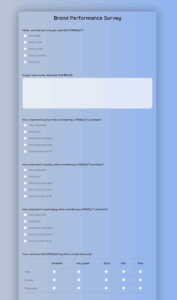Creating a safe and healthy workplace isn’t just a legal requirement; it’s a fundamental commitment to your employees’ well-being and, ultimately, your organization’s success. But how do you truly know if your current safety protocols are effective, or if there are hidden hazards lurking that you haven’t even considered? The best way to get a clear picture is by asking the people on the front lines: your employees. That’s where a well-designed health and safety survey comes into play, offering invaluable insights directly from those who experience the workplace environment daily.
Think of a health and safety survey as your direct line to understanding the pulse of your workplace’s safety culture. It’s not just about ticking boxes for compliance; it’s about fostering an environment where everyone feels secure, valued, and empowered to contribute to a safer collective. Using a robust health and safety survey template can streamline this process, ensuring you cover all critical areas and gather actionable feedback efficiently. It helps transform abstract safety goals into concrete improvements that genuinely make a difference.
Why A Health And Safety Survey Is Crucial For Your Organization
Engaging your workforce through a comprehensive health and safety survey offers a multitude of benefits that extend far beyond simple compliance. Firstly, it allows you to proactively identify potential hazards that might otherwise go unnoticed. Employees often have a unique perspective on the day-to-day operations and can pinpoint risks that management might overlook from a higher level. This grassroots feedback is essential for maintaining a truly safe environment.
Secondly, a well-executed survey demonstrates to your employees that their well-being is a top priority. When staff feel heard and valued, it significantly boosts morale and fosters a stronger sense of trust between management and the workforce. This increased trust often translates into greater engagement, a willingness to report issues, and a more positive overall workplace culture. It shifts safety from being just a set of rules to a shared responsibility.
Beyond the immediate benefits, conducting regular health and safety surveys provides a historical record of your safety performance and improvements over time. This data can be incredibly valuable for internal reviews, external audits, and even for demonstrating due diligence in the event of an incident. It allows you to track progress, measure the effectiveness of new safety initiatives, and make data-driven decisions about future policies and training.
Furthermore, these surveys can uncover areas where training might be lacking or where specific procedures are misunderstood. Perhaps a particular piece of equipment is consistently causing minor issues, or an emergency evacuation plan isn’t fully clear to everyone. A survey can highlight these gaps, allowing you to fine-tune your training programs and refine your protocols for maximum effectiveness.
Key Areas A Health And Safety Survey Template Should Cover
To ensure your survey is comprehensive and truly insightful, your health and safety survey template should address a range of critical categories. These categories ensure you gather a holistic view of your workplace’s safety landscape.
- General Workplace Environment: Questions about cleanliness, lighting, noise levels, and overall organization.
- Equipment and Machinery Safety: Inquiry into the condition, maintenance, and safe operation of tools and machinery.
- Emergency Preparedness: Assessing awareness of evacuation routes, fire safety procedures, first aid availability, and emergency contact protocols.
- Hazard Identification and Reporting: Understanding how easily employees can report hazards and whether they feel their concerns are addressed.
- Training and Communication: Evaluating the effectiveness of safety training, clarity of safety policies, and how well safety information is communicated.
- Ergonomics: Questions related to workstation setup, repetitive tasks, and potential for strain or injury.
- Chemical and Substance Safety: If applicable, assessing awareness of MSDS/SDS sheets, proper handling, and storage of hazardous materials.
- Employee Well-being and Stress: Exploring factors that might contribute to stress or mental health challenges in the workplace.
Crafting Your Effective Health And Safety Survey Template
Once you understand the importance and key components, the next step is to actually put together a health and safety survey template that truly works for your organization. The design of your survey is just as crucial as its content. Aim for clarity and conciseness. Long, convoluted questions can lead to survey fatigue and less accurate responses. Use simple language and avoid jargon wherever possible, ensuring that every employee, regardless of their role or background, can easily understand and answer the questions.
Consider the length of your survey carefully. While you want to be thorough, an excessively long survey can deter participation. Break it down into logical sections and perhaps offer a mix of question types: multiple choice, rating scales, and a few open-ended questions for qualitative feedback. Open-ended questions are particularly valuable as they allow employees to express concerns or suggestions that you might not have anticipated, providing rich, detailed insights.
Anonymity is paramount for a successful health and safety survey. Employees are far more likely to provide honest and critical feedback if they are confident that their responses cannot be traced back to them. Clearly state the anonymity of the survey at the beginning and ensure your chosen survey platform supports this. Reassure your team that the purpose of the survey is solely to improve safety and health for everyone, not to assign blame.
Finally, remember that the survey itself is only the first step. The true value comes from analyzing the responses and, most importantly, acting on the feedback received. Develop a clear plan for reviewing the data, identifying key trends and areas of concern, and then communicating what actions will be taken as a result. This follow-up demonstrates your commitment to their input and reinforces the positive cycle of continuous improvement in workplace safety.
Implementing a regular feedback mechanism, such as an annual or bi-annual health and safety survey using a carefully designed template, is a proactive measure that pays dividends. It allows you to consistently monitor the effectiveness of your safety programs, identify emerging risks, and ensure that your workplace remains a safe haven for everyone. It’s an investment in your people and your future.
By making the health and safety survey a routine part of your operational strategy, you’re not just complying with regulations; you’re actively cultivating a resilient and safety-conscious culture. This continuous engagement and improvement process solidifies your commitment to well-being, fostering an environment where safety is always top of mind, benefiting both the individual and the organization as a whole.


